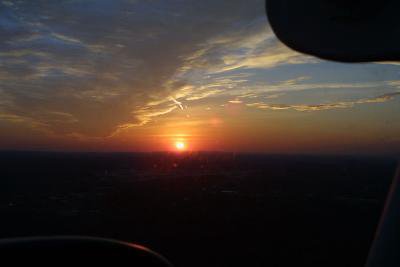More foggle time
Two days of awesome flying and two very different experiences.
Yesterday was hazy, sunny and very smooth. Ron and I headed out in the afternoon for practice approaches at Charlottesville, VA. I'd love to describe the area, which I gather is quite picturesque, but I was stuck under the hood for the duration of the flight, save a few precious minutes. The flight over was uneventful and within half-an-hour after leaving Manassas we got vectors to shoot the ILS3 circle to 21.
Since the air was smooth as glass, flying the approach was quite easy and I lifted the hood at circling minimums to join a left downwind to 21. (The hood, or foggles in this case, is a inhumane device intended to limit the instrument student's view beyond the instrument panel, thereby simulating flying in the clouds. I can't wait to burn the damn thing!)
I flew the pattern as a regional jet took off and went missed. As we climbed out I tried to enjoy the view for a second, knowing I'd be back in "the clouds" shortly.
KCHO seems like a nice destination surrounded by mountains. It had a bucolic feeling with fields, forests and even a hot air balloon floating peacefuly in the distant haze.
Approach gave us missed approach instructions and we came back around to shoot the ILS a second time.
"For some reason these airplanes don't like this approach," Ron told me.
Busy fiddling with knobs and reviewing the approach plate I wondered what the heck he was talking about.
"Sometimes they just shut down one engine because they hate it so much," he continued.
Oh, I get it now...
As I received my final vector to intercept the localizer, the plane yawed suddenly as my left engine "died." Ran through the memory emergency checklist and continued the approach. Again, since there was no wind to speak of, it was pretty easy and after a nice clean ILS I lifted the hood to see the runway right in front of me. No matter how easy the conditions are, it's always a nice feeling! Went missed again, the the full published missed this time.
I managed to screw up the hold at Gordonsville VOR a little. The entry was fine although winds aloft pushed us a little out so intercepting the inbound took a little longer than expected.
From there we headed back to Manassas for the ILS16L on one engine. Again, nonexistant winds really helped me out and I greased the landing.
Fast forward to today...
It took us a while to decide whether to fly or not. The temperature at the field was in the 40s, while airports between 20 and 50 miles away showed temperatures in the 70s. Perfect conditions for Ron to show me a warm front. He was concerned, however, that a low pressure system to our west would push colder air into the area and create temperature inversions, which could bring icing.
As the afternoon went on, however, the clouds remained high and Ron decided it was safe to go.
We took off minutes later in pretty bumpy skies, but hey we got to go fly, right?!
As we neared the mountains around Charlottesville, however, the bumps got bigger and we were getting seriously thrown around. The course reversal for the GPS21 was interesting since it was right over the mountains. I fought the plane all the way in. As I went visual I had to crab 30 degrees or more into the wind and still couldn't hold centerline as the capricious wind forced the Seminole to yaw left and right. Wind shear of +/- 15kts was also wreaking havoc with what I'd hoped would be the perfect approach.
I went missed and took a breather on the way up. My palms were sweaty and I felt I'd flown the approach badly. The bumps obviously didn't help but in my efforts to tame the plane and remain on heading and altitude on the way down I tended to fixate, one of the instrument pilot's worst enemies, or forget details.
In the short time since we'd gone missed, the wind turned almost 180 degrees, so we received vectors for the ILS3 for our second run.
Again, the bumps and gusts made the approach difficult and while it wasn't necessarily graceful I flew it OK. Not great, but it wasn't a complete disaster. As we reached the DH, Ron and I agreed we were happy we didn't have to land there! It was a workout but great experience.
Published missed to the hold, where I picked up our clearance home and back to Manassas for the GPS34R, which went well. Our ground speed to the FAF was up to around 170kts, I believe. As we turned onto the final approach course, it dipped as low as 50kts and never exceeded 70kts.
The winds are back...



0 Comments:
Post a Comment
<< Home